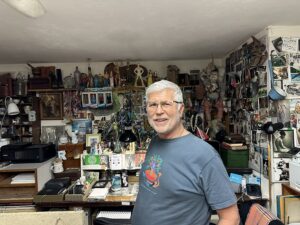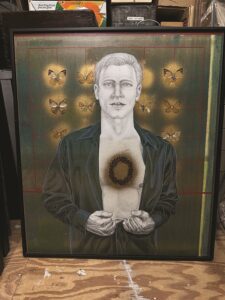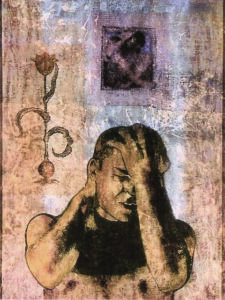Robert Adamcik has become a Provincetown local. With dry humor, he’ll give you his opinions on everything in town, from the best galleries, shows, and lobster rolls to the worst kinds of tourists. Adamcik, 75, who started visiting Provincetown in the ’60s and has been living here since 1991, supports himself by working retail in the summer, this year, at Century, and then, come winter, returning to his art studio. The off-season is his time to pursue his passion, and he says, “When you get to be my age, it’s all about time.”

The home he shares with his husband, Brian Cabral, overflows with local artists’ work. Paintings and sculptures cover every inch of their West End condo.
He first came to Provincetown because it was the most accepting place to be out. “You could still get harassed,” he says, “but it was a whole lot freer than any other place.” He dreamed about moving to Provincetown full-time and becoming an artist. In the summer of 1991, he asked himself what was holding him back, and he took the leap, quitting his day job in Boston as a videographer. That summer, he worked as a houseboy and lived, he says, “literally in a shack — which I loved.”
As a child, Adamcik was fascinated by ancient Roman and Greek statuary and Renaissance paintings. It wasn’t until Teresa Williams, his high school art teacher in Coventry, Conn., took him under her wing that he began to see art as more than a hobby. With her support, Adamcik won a scholarship to the Rhode Island School of Design, graduating in 1970.

Many of his paintings include an illustration of a male figure surrounded or overlapped by a collage of other images. In A Calling, a figure with a crown of thorns lodged in the center of his chest stands in front of pinned butterflies. Adamcik says he’s “a magpie” and that much of the material for his work comes from discarded items he has collected over the years. A Calling was created on overlaid misprinted newsprint that was used as packing for items that came to Wah, a now-closed store where Adamcik worked. The piece, both in its use of interwoven and repurposed materials and in the composition itself, grapples with the tension between the interior and exterior self. The crown suggests that the figure’s revelation of his suffering is a pathway toward personal or even collective redemption.
In his art, Adamcik confronts the trauma he and other gay men have faced. “I think that there is no gay person who has made it through life without some residue of being the outsider, being the other, being considered a sinner or a criminal,” he says. “So, you go through your life and with any luck, like in my case, my life is great, my life is rich, but there’s still that residue.”
His work is not about any one thing: grief and beauty often become indistinguishable. Where Are You Now? was created soon after Adamcik’s father died. He says that, although toward the end of his father’s life they were on good terms, they had a “very complicated relationship.” In the piece, Adamcik captures the dualities of his sorrow, represented by the main figure’s crumpled body and the potential for healing represented by the ever-growing flower. The small boxed-in and slightly faded figure toward the top of the painting also alludes to this complexity, as he is simultaneously confined and on the verge of escape.

Adamcik is unafraid to stare down life’s complexity. At first glance, the work appears mired in a suffering that loses sight of how confronting life’s relentless dualities is the only way to live authentically. “Somebody once said, ‘Your work is so depressing,’ ” he says. “I said, ‘No, it’s not. These are the things I’ve experienced, and I put them down here, and then I let them go.’ ”
Adamcik is grateful he made the leap to Provincetown. “The only way I’m moving out of here is feet first,” he says. “There’s no other place I would rather be.” He says that there is still a thriving community of artists who support each other, though he worries about the town’s “Nantucketization” — becoming a “playground for the idle rich.” He says that many of the artists and galleries he first worked with have been forced out of town, and that more should be done to make Provincetown welcoming to artists.
Adamcik’s work will be on display next summer at the Provincetown Commons, the dates still to be determined. He relishes the freedom in being able to work for himself, creating art for its own sake. “No matter what, I just can’t stop making it,” he says, pointing to a new canvas on an easel. In a few months, after the shops have shut down, Adamcik will return full-time to his studio and get back to work.



